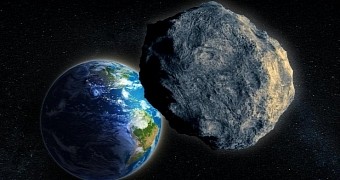Earlier this month, the International Astronomical Union's Minor Planet Center in the city of Cambridge in Massachusetts, US, honored the country's University of Utah in Salt Lake City by naming an asteroid after it.
The space rock, whose former and totally not appealing name was 391795 (2008 RV77), will from now on be known as Univofutah. Apparently, university marketing officials first went for the name Univ of Utah, and then tried to negotiate for U of Utah.
However, folks at the International Astronomical Union's Minor Planet Center decided that Univofutah was by far the best choice, and so the asteroid got stuck with this name. Hopefully, its friends won't poke fun at it over this moniker.
Introducing Univofutah
This asteroid was discovered back in September, 2008, by an astronomy enthusiast and University of Utah professor named Patrick Wiggins, who this year was awarded NASA's Distinguished Public Service Medal for his work as a solar system ambassador to Utah.
At the time Patrick Wiggins spotted it with the help of a telescope, the space rock was located at a distance of about 137 million miles (220 million kilometers) from Earth. This is the equivalent of 1.5 times the distance between Earth and the Sun, EurekAlert explains.
Since the space rock sits at a considerable distance from our planet, scientists are not in the least worried that it might one day go haywire and embark on a crash course to Earth. Thus, it is currently located between the orbits of Mars and Jupiter.
In fact, Univofutah is so far from our planet that the Hubble Space Telescope is having serious trouble making heads or Tails of its shape. “It's a loooong way out. It is in the main asteroid belt. It stays between the orbits or Mars and Jupiter,” Patrick Wiggins said in a statement.
The asteroid is estimated to measure about 1 mile (approximately 1.6 kilometers) in width. This figure might sound impressive to ordinary folks, but astronomers say that, when compared to other space rocks out there, Univofutah is embarrassingly small.
Commenting on the decision to name this asteroid after the University of Utah, Patrick Wiggins said, “It's neat. There aren't too many other universities on the whole planet with asteroids named after them. So that puts the U in rather rarified company.”
“We are very honored. Patrick Wiggins has been a dedicated champion of Utah amateur astronomy. Next, we'll need student volunteers to install a large block U on our asteroid,” added Carleton Detar, the University's chairman of physics and astronomy.
There are thousands of asteroids flying about in space
This might come as a surprise to some people, but as it turns out, asteroids are a fairly common sight in space. In fact, about 655,500 have until now been discovered by scientists, and thousands more are discovered every year. Of these space rocks, most sit mind-bogglingly far from our planet.
Astronomers say that, although they make headlines quite often, so-called near-Earth asteroids are actually quite rare. More precisely, just 11,473 such space rocks have until now been found. Unlike other asteroids, near-Earth ones have orbits that can bring them close to our planet.

 14 DAY TRIAL //
14 DAY TRIAL //